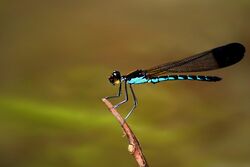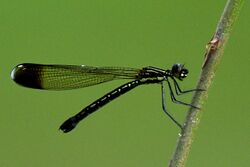Biology:Calocypha laidlawi
| Calocypha laidlawi | |
|---|---|

| |
| Male | |

| |
| Female | |
| Scientific classification | |
| Domain: | Eukaryota |
| Kingdom: | Animalia |
| Phylum: | Arthropoda |
| Class: | Insecta |
| Order: | Odonata |
| Suborder: | Zygoptera |
| Family: | Chlorocyphidae |
| Genus: | Calocypha |
| Species: | C. laidlawi
|
| Binomial name | |
| Calocypha laidlawi (Fraser, 1924)
| |
| Synonyms | |
|
Rhinocypha laidlawi Fraser, 1924 | |
Calocypha laidlawi,[2] or myristica sapphire,[3][4] is a rare species of damselfly belonging to the family Chlorocyphidae. It is found only from Karnataka and Kerala in South India.[1][5]
Description and habitat
It is a small damselfly with big eyes and several vermilion spots on the head. Its thorax is dark with a narrow vermilion mark on dorsum and pale yellow marks on the lower part of lateral sides. The apical third of each wing is black with dark violet-metallic reflections. Its abdomen is black, marked with bright azure blue on segments 1 to 8.[6]
Female is black with yellow markings on the face, thorax and abdomen. Abdomen is black, marked with yellow mid-lateral stripes and dots in segments 2 to 7. Fore-wings are transparent. Apices of the hind-wings are broadly brown. Pterostigma are with inner half black and outer half white.[6]
It breeds in forest streams and rivers flowing through the myristica swamps. It is commonly found perched on half-submerged logs in mid-stream or resting on twigs overhanging the river.[7][6][8][3][4] It is a shade-lover; found perched on partially submerged logs in mid-stream or resting on overhanging twigs in the river.[6]
See also
- List of odonates of India
- List of odonata of Kerala
References
- ↑ 1.0 1.1 Dow, R.A. (2009). "Calocypha laidlawi". IUCN Red List of Threatened Species 2009: e.T163604A5622415. doi:10.2305/IUCN.UK.2009-2.RLTS.T163604A5622415.en. https://www.iucnredlist.org/species/163604/5622415. Retrieved 20 November 2021.
- ↑ "World Odonata List". University of Puget Sound. https://www.pugetsound.edu/academics/academic-resources/slater-museum/biodiversity-resources/dragonflies/world-odonata-list2/.
- ↑ 3.0 3.1 "Calocypha laidlawi Fraser, 1924". India Biodiversity Portal. http://indiabiodiversity.org/species/show/226771.
- ↑ 4.0 4.1 "Calocypha laidlawi Fraser, 1924". Odonata of India, v. 1.00. Indian Foundation for Butterflies. http://www.indianodonata.org/sp/250/Calocypha-laidlawi.
- ↑ K.A., Subramanian; K.G., Emiliyamma; R., Babu; C., Radhakrishnan; S.S., Talmale (2018). Atlas of Odonata (Insecta) of the Western Ghats, India. Zoological Survey of India. pp. 74–75. ISBN 9788181714954.
- ↑ 6.0 6.1 6.2 6.3 C FC Lt. Fraser (1934). The Fauna of British India, including Ceylon and Burma, Odonata Vol. II. Red Lion Court, Fleet Street, London: Taylor and Francis. pp. 53-55. https://archive.org/details/FraserOdonata2.
- ↑ Subramanian, K. A. (2005). Dragonflies and Damselflies of Peninsular India - A Field Guide. http://www.ias.ac.in/Publications/Overview/Dragonflies.
- ↑ C FC Lt. Fraser (1924). A Survey of the Odonate (Dragonfly) Fauna of Western India and Descriptions of Thirty New Species. pp. 482–483. http://faunaofindia.nic.in/PDFVolumes/records/026/05/0423-0522.pdf.
External links
Wikidata ☰ Q7288928 entry
 |


